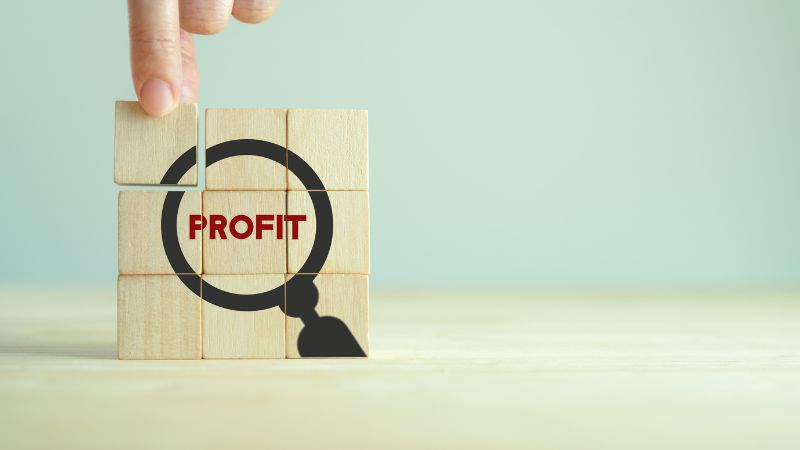Categories
How to Calculate Business Profit

Profit - the primary way of seeing whether your company is successful (making a profit), or struggling (not making a profit). But how do you truly calculate profit, what does it mean, and what are the impacts on your business planning?
Join us as we dive into exactly how to calculate profit.
How to Calculate Business Profit
The simple equation for calculating business profit is:
But the real answer is more complicated than that.
Here are 4 aspects of your business you need to look at to calculate your actual profit, and the different types of profit you can calculate.
- Revenue
- Gross Profit
- Operating Profit
- Net Profit
Let's look at each of these in more detail.

1 - Revenue
At the very top of the profit calculation pile, stands revenue. This figure represents the total money that has come into the business in the financial year from normal business operations.
It can be estimated as the average sale price x number of sales, though a precise revenue should be calculated and recorded on your balance sheet.
Revenue is also referred to as ‘sales’ or the ‘top line’.

2 - Gross Profit
The first layer of profit, gross profit takes into account the direct costs of your business, and calculates whether your business is making money from producing and selling the goods it sells, or offering the service it offers.
The calculation for gross profit is:
In order to properly understand gross profit, it is vital to understand what is meant by ‘direct costs’.
Understanding Direct and Indirect Costs
Gross profit calculates whether the cost of making the goods or providing the service that your company provides is worthwhile. It takes only the direct costs into account, also known as costs of goods sold (COGS), or costs of service (COS).
Calculating the difference between direct costs and indirect costs can be complicated. Direct costs include any money that has to be paid out to produce the goods, or provide the service, while indirect costs covers money that is paid to generally run the business but cannot specifically be tied to the goods or service.
Some examples of direct or indirect costs are detailed below:
Examples of Direct or Indirect Cost
|
Item |
Direct or Indirect |
Explanation |
|
Raw materials to make product |
Direct |
Production materials can be directly tied on 1 :1 basis with the products created. |
|
Electricity bill |
Indirect |
Though electricity is used to create the product, it is an ongoing overhead and the cost of electricity per product created is not calculated. |
|
Contracted specialist used to create product |
Direct |
The contracted specialist is only brought in to create the product and wouldn’t otherwise be required; their cost is clearly linked to the product. |
|
Office rent |
Indirect |
Like electricity, the ongoing rent payment is not directly tied to a given product but is part of the overheads for running the business. |
|
Sales person salary |
Indirect |
Ongoing sales work is a general overhead for the business and is not directly tied to any product or service. |
|
Sales person commission |
Direct |
A specific bonus or commission paid for the sale of a product or service can be directly tied to that product and should be considered a direct expense. |
|
Manager salary |
Indirect |
Management and administrative salaries are not linked to the production of goods or services. |
|
Shipping costs |
Direct |
The cost of shipping your products to your customers can be linked to the specific products and is thus a direct cost. |
|
Insurance |
Indirect |
Another example of an ongoing expense, business insurance is not directly linked to the products. |
|
Factory worker salary |
Indirect |
A factory worker on an ongoing salary will be paid irrespective of the number of goods produced, thus their salary is considered indirect rather than a direct cost. |
|
Factory worker wages |
Direct |
As non-salaried wages are only paid when work is done, they can be tied directly to the goods and products and are thus a direct cost. |
|
Ongoing asset depreciation |
Indirect / Direct |
Assets used in the production of goods and services are typically considered an indirect asset, however there are cases where depreciation is a direct cost. These specific cases should be discussed with your accountant. |
Properly assessing your direct costs is essential to calculating gross profit.


3 - Operating Profit
Underneath gross profit, comes operating profit. This is the profit that is calculated once all the indirect operating expenses are considered.
Where gross profit has already accounted for direct costs, now indirect costs such as payroll, rent, and utilities are all factored into the calculation:
With these expenses taken into account, operating profit provides a clearer view to how much the business is making.
Operating profit is also known as operating income or earnings before interest and taxes (EBIT).

4 - Net Profit
The bottom line, net profit is the final profit figure, calculated by deducing taxes and any business loan interest from the operating profit.
For many business owners, it is the net profit that best indicates the business health, allowing them to evaluate the situation and determine what adjustments need to be made to better improve the business in the coming year.
Net profit is also known as the bottom line or net income.

How to Calculate Profit Margins
The core profit calculations do not represent the end of important metrics when looking at profit. There is also the profit margin, a percentage calculation that offers immediate insight into the business's profitability.
Profit margins are calculated as follows:
Like the profit calculations themselves, gross profit margin, operating profit margin, and net profit margin provide different insights into how well the business is doing, taking different aspects into account. For business owners looking to see the overall profitability of a business, the net profit margin is often the most interesting of all the profit calculations.
Improving Profit with Clifton Private Finance
While we can’t directly boost your company profits, our advisors are here for you on financial matters, offering a range of help and financial services to ensure your business runs smoothly. Whether it’s help with cash flow to see you through a dry spell, or a business loan to enable you to invest in the future, Clifton Private Finance have the answers. Contact us today to find out more.
To see what we can do for you, call us on 0203 900 4322 or book a free consultation below.











